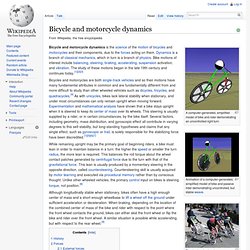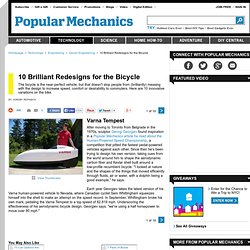

Www.pgccphy.net/rec/rec004-bicycle.pdf. Screen shot and description for virtual bicycle simulation with force vectors. Bicycle Transmission Physics. Bikes are pretty simple machines.

Completely enjoyable without special mathematical treatment. But if you’re an obsessive engineering-type geek like me, you’ll feel better when you have a little math to go with all that exercise. This is a real simplified run through power transmission in a bicycle as I understand it. The numbers check out as do the units of measure. Somebody call bullshit if you see it. Definitions First, some definitions. Power – The rate at which work is done. Work – Power integrated over time. Force – A force acts on a body to produce an acceleration. Torque – A measure of a force’s tendency to produce rotation. Assumptions Let’s assume that a random dude is driving a bike down the road. We’ll ignore the wind. Pedals and Crank Force is applied to pedals. The crank is fastened to the bike chainring. The torque on the crank is 111.5 ft-lbs if the crank is 170mm or 6.7 inches 200lbs * (6.67 inches/12 inches/ft) = 111.5 ft*lbs Chain.
Bicycle and motorcycle dynamics. A computer-generated, simplified model of bike and rider demonstrating an uncontrolled right turn.

Animation of a computer-generated, simplified model of bike and passive rider demonstrating uncontrolled, but stable weave. While remaining upright may be the primary goal of beginning riders, a bike must lean in order to maintain balance in a turn: the higher the speed or smaller the turn radius, the more lean is required. This balances the roll torque about the wheel contact patches generated by centrifugal force due to the turn with that of the gravitational force. This lean is usually produced by a momentary steering in the opposite direction, called countersteering. Countersteering skill is usually acquired by motor learning and executed via procedural memory rather than by conscious thought. History[edit] The history of the study of bike dynamics is nearly as old as the bicycle itself. Bicycle Designs - 10 Brilliant Bike Designs. Most cyclists and gym-equipment enthusiasts would ask why anyone would ever want to combine a bicycle with an elliptical machine.

Engineer and ultramarathoner Brent Teal's answer may not satisfy the diehards, but he can tell you just how to do it. After a year spent building five prototypes out of off-the-shelf steel tubing, abandoned bike parts and skateboard decks, and riding thousands of test miles on these DIY bike mashups, Teal built ElliptiGo, the first ever bike-cum-ellipitcal machine.
One of the most difficult parts of building this bike, which was the brain child of injury-plagued Ironman athlete Bryan Pate, was getting the long stride length, Teal says. To extend the frame and create an adjustable platform, Teal designed a long span in the middle of the bike that was light and rigid. Crank arms attached to this platform are made from 7000-series aluminum, and to keep it light, the platforms that hold bikers are made of carbon fiber. Physics of a Riderless Bicycle - Why Doesn't a Bike Fall Over. Web.phys.ksu.edu/papers/2005/The_Bicycle_india.pdf. Swiss Physical Society - Physics of bicycle riding. The Bicycle Power Calculator Exposes the Physics of Cycling. Photo: Christa, Flickr, CCThe Spec Sheet for the Human-Bike CyborgThis one is an oldie (1999 is ancient in internet time...) but a goodie that bike geeks will find interesting.

It's a bicycle power calculator that tells you how much energy you need to generate while pedalling your bike, and it even breaks it down between the energy needed to overcome rolling resistance, air friction, mechanical losses, etc. It's pretty precise and takes into account wheel size, speed, rider position, gear ratio, tire type, etc. Image: Screen grab of Bicycle Power Calculator website The most interesting thing, in my opinion, is to see how quickly air resistance goes up as you increase speed.
It's no secret to most people familiar with bikes and cars (and other fast things), but it's nice to be able to play with the variables (including the rider position, as some are much more aerodynamic) and see how much energy you need to expand just to move air. The Physics of Bicycling. How Bikes Work. As of July 1, 2013 ThinkQuest has been discontinued.

We would like to thank everyone for being a part of the ThinkQuest global community: Students - For your limitless creativity and innovation, which inspires us all. Teachers - For your passion in guiding students on their quest. Partners - For your unwavering support and evangelism. Parents - For supporting the use of technology not only as an instrument of learning, but as a means of creating knowledge. We encourage everyone to continue to “Think, Create and Collaborate,” unleashing the power of technology to teach, share, and inspire. Best wishes, The Oracle Education Foundation. Bicycle Physics. THE PHYSICS OF BICYCLES.